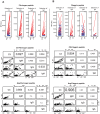Bead arrays for antibody and complement profiling reveal joint contribution of antibody isotypes to C3 deposition
- PMID: 24797804
- PMCID: PMC4010547
- DOI: 10.1371/journal.pone.0096403
Bead arrays for antibody and complement profiling reveal joint contribution of antibody isotypes to C3 deposition
Abstract
The development of antigen arrays has provided researchers with great tools to identify reactivities against self or foreign antigens from body fluids. Yet, these approaches mostly do not address antibody isotypes and their effector functions even though these are key points for a more detailed understanding of disease processes. Here, we present a bead array-based assay for a multiplexed determination of antigen-specific antibody levels in parallel with their properties for complement activation. We measured the deposition of C3 fragments from serum samples to reflect the degree of complement activation via all three complement activation pathways. We utilized the assay on a bead array containing native and citrullinated peptide antigens to investigate the levels of IgG, IgM and IgA autoantibodies along with their complement activating properties in serum samples of 41 rheumatoid arthritis patients and 40 controls. Our analysis revealed significantly higher IgG reactivity against the citrullinated fibrinogen β and filaggrin peptides as well as an IgA reactivity that was exclusive for citrullinated fibrinogen β peptide and C3 deposition in rheumatoid arthritis patients. In addition, we characterized the humoral immune response against the viral EBNA-1 antigen to demonstrate the applicability of this assay beyond autoimmune conditions. We observed that particular buffer compositions were demanded for separate measurement of antibody reactivity and complement activation, as detection of antigen-antibody complexes appeared to be masked due to C3 deposition. We also found that rheumatoid factors of IgM isotype altered C3 deposition and introduced false-positive reactivities against EBNA-1 antigen. In conclusion, the presented bead-based assay setup can be utilized to profile antibody reactivities and immune-complex induced complement activation in a high-throughput manner and could facilitate the understanding and diagnosis of several diseases where complement activation plays role in the pathomechanism.
Conflict of interest statement
Figures






References
-
- Miersch S, Bian X, Wallstrom G, Sibani S, Logvinenko T, et al. (2013) Serological autoantibody profiling of type 1 diabetes by protein arrays. J Proteomics 94: 486–496. - PubMed
-
- Prechl J, Papp K, Erdei A (2010) Antigen microarrays: descriptive chemistry or functional immunomics? Trends Immunol 31: 133–137. - PubMed
-
- Dunkelberger JR, Song WC (2010) Complement and its role in innate and adaptive immune responses. Cell Res 20: 34–50. - PubMed
Publication types
MeSH terms
Substances
LinkOut - more resources
Full Text Sources
Other Literature Sources
Miscellaneous

